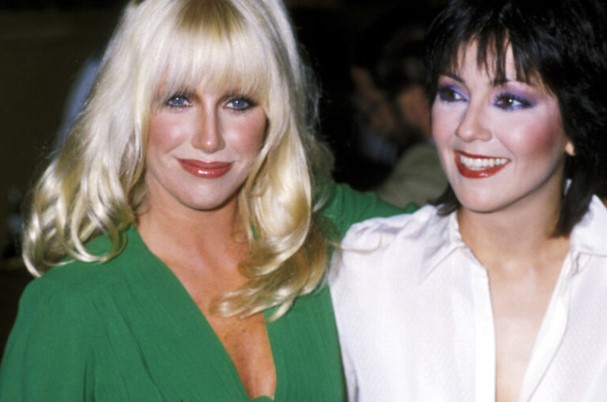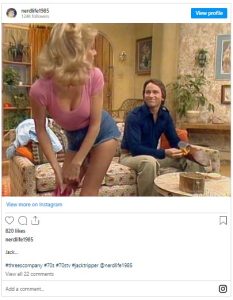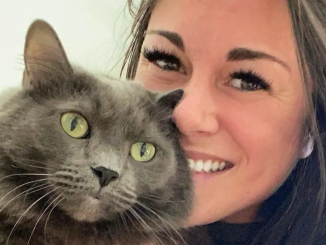
Decades may have passed since Three’s Company graced our screens, but its laughter still echoes in our hearts.
With unforgettable characters and side-splitting misunderstandings, this classic sitcom revolutionized the genre. Now, Joyce DeWitt reveals what really made the show a timeless treasure…

Public Domain
From the hilarious antics of three single roommates to the unforgettable performances of John Ritter and Suzanne Somers, Three’s Company remains a beloved staple of American television. It’s hard to believe it’s been 40 years since the series finale aired on ABC, yet its charm and humor still resonate today.
To illustrate how long ago Three’s Company became a hit, I just watched the intro. Seeing the shots from Santa Monica Pier during the show’s prime reminds me of how much has changed since they filmed there.
Sadly, neither John Ritter nor Suzanne Somers are with us anymore; both were taken from us far too soon. But keeping the spirit of Three’s Company alive is Joyce DeWitt, 75, who shares her vibrant stories and cherished memories from the beloved show.
”The most dear, precious, tender – and utterly unexpected – experiences that have come from working in ‘Three’s Company’ are the many, many adults who have told me that ‘Three’s Company’ was a safe haven they could count on during their teen years – for some, the only safe haven,” Joyce DeWitt told US Weekly.

Joyce DeWitt circa 1978. (Photo by Images Press/IMAGES/Getty Images)
Starring as Janet Wood alongside John Ritter and Suzanne Somers, DeWitt became a television icon and she was such a day brightener for millions.
She appeared in 171 episodes of the show between 1976 and 1984.
“It was such a gift. I mean, it was iconic. But who would have thought it?” Joyce DeWitt told The Spec. “All we were trying to do was make people laugh. When I think about it, the show was really an attempt to do a contemporary version of a 16th-century farce. It was about silliness running wild. I mean, we were talking about serious issues at times, but that was always somewhere underneath.”
“John Ritter used to say, ‘We don’t want people to just laugh but to fall over their couch laughing,’” she added. “The real issue was always the depth of friendship and the love those characters had for each other. That’s what drew people to them.”

Flickr
After Three’s Company ended, DeWitt stepped away from the spotlight for over a decade before making her comeback to acting.
Yet, no matter what she has accomplished or plans to do in the future, the vast majority will always connect her with that iconic show. And there’s a very simple reason for that, according to DeWitt.
“It was a ‘time out’ from the oppressive, challenging, difficult circumstances they were navigating in their young lives,” DeWitt says and adds:
“And, oh by the way, they say the characters also did stupid, crazy stuff that made them laugh. But it was the love, trust and support of the characters, one to the other, that made them lifelong fans.”

Public Domain
When you look at unedited photos from the Three’s Company set, the camaraderie among the cast shines through, especially in the images of Joyce DeWitt and Suzanne Somers, who played the beloved Chrissy Snow.
Both actresses delivered iconic performances, portraying young women navigating a male-dominated industry. They contributed just as much to the show’s success as John Ritter, and in those early days, their smiles in photos tell a story of friendship and collaboration.
Yet, beneath the laughter, tensions simmered. While Somers was celebrated for her role as “the dumbest blonde in America,” her fight for equal pay created rifts that would grow over time. As she demanded a 500% salary increase — from $30,000 to $150,000 — her relationship with DeWitt became strained. The set, once filled with joy, was now fraught with conflict.

Somers had always viewed the show as a business among serious actors, and she realized that her approach annoyed her co-stars.
Somers was ultimately fired but had to finish the fifth season under strange circumstances. Isolated from her castmates, she filmed her scenes through bizarre phone calls, escorted by security. The tension escalated, leading to a heartbreaking split between Somers and DeWitt.
For over 30 years, they didn’t speak, a silence that seemed hard to reconcile when you viewed their early years together.

”They painted me as she’s trying to ruin the show,” Somers said in 2020. “So, I never talked to anybody on that show ever again. Ever again.”
Some speculated that DeWitt’s rivalry contributed to Somers’ exit, but it was ultimately the salary negotiations that drove a wedge between them.
Their differing circumstances — Somers as a single mother needing financial security versus DeWitt’s focus on her craft — further complicated their relationship.

“We had very different approaches to our careers,” DeWitt said of the relationship between her and Somers following the show. “We had very different needs. I did not have a child that I was supporting on my own. I didn’t have a business head, so I didn’t understand someone who did.”
However, in a beautiful twist, the two finally reunited in February 2012 on Somers’ talk show, Breaking Through. It was clear that they had buried the hatchet.
The former co-stars shared a heartfelt hug, and their open conversation about the past offered a glimpse of healing.
DeWitt expressed her deep respect for Somers’s accomplishments, saying, “You went up against ruthlessness, and it came down, but what you’ve gone on to do is immeasurable.” This moment highlighted the strength of their journey and the power of reconciliation. The two actresses remained friends until Somers’s tragic passing in 2023.

Getty Images
In the interview with US Weekly, DeWitt spoke fondly of her late co-stars, paying tribute to their lasting impact. Reflecting on Somers, who passed away from breast cancer, DeWitt described her as ”absolutely wonderful.”
She also honored Ritter, who died in 2003 during heart surgery, calling him ”a true gift.”
As we revisit the photos from Three’s Company, we are transported back to a different, happier time—one brimming with laughter, friendship, and unforgettable moments. These images from the set not only celebrate the joy the cast brought to our screens but also highlight the enduring legacy they have left behind.

Public Domain
RIP John Ritter and Suzanne Somers – gone but never forgotten!
In her youth, Hollywood celebrated her as a true beauty: With her flowing blonde hair and striking blue eyes, the actress was considered one of the most beautiful stars in the film industry
Kathleen Turner rose to fame in the 1980s, known for her captivating presence and beauty. Many consider her to be one of Hollywood’s most impressive actresses, and her resilience has helped her navigate the ups and downs of her career and personal life.
Growing up in a family of four, Kathleen faced hardships from an early age, including the sudden death of her father while mowing the lawn in Hampstead. Just a month later, her family was forced to leave the UK and moved to Springfield, Missouri, where she continued to grieve.
As an adult, Kathleen found solace in New York while pursuing acting. At first she enjoyed stage work, but her big break came in 1981 with the role of a femme fatale in “Body Heat”. A few years later, she co-starred with Michael Douglas in “Romancing the Stone”, where the chemistry between them sparked romantic feelings, even though Douglas was separated from his wife at the time.
Kathleen married real estate developer Jay Weiss in 1984 and they had their daughter Rachel Ann in 1987. However, their marriage faced challenges as they raised their child. Kathleen felt the pressure of balancing work and family, which led to feelings of guilt and oppression.

In 2005, he starred in the Broadway revival of “Who’s Afraid of Virginia Woolf?” Their marital problems worsened. Eventually, the couple divorced amicably and Kathleen received a Tony Award nomination for her role in the play.
She had a successful film career in the 1980s and received an Oscar nomination for “Peggy Sue Got Married”. However, the 1990s brought health problems when Kathleen developed rheumatoid arthritis, which caused severe pain and limited her mobility. She found herself in an identity crisis and questioned her future as an actress.
She initially turned to drugs and alcohol to cope, but after a short stay in rehab, she found that her problems were manageable with better medication tracking. Today, she practices yoga and Pilates to stay active and manage her pain.
As she grew older, Kathleen focused more on theater and returned to her roots. In her forties, she acted in productions such as Cat on a Hot Tin Roof. She also devoted herself to causes she believed in, such as volunteering for Amnesty International and Planned Parenthood.

A lifelong feminist, Kathleen Turner uses her platform to empower women and support them on their journey to independence. Her philosophies are highlighted in Gloria Feldt’s 2008 memoir, Send Yourself Roses, where she reflects on women’s empowerment. What do you think about Kathleen Turner’s inspiring journey? Share it in the comments!



Leave a Reply